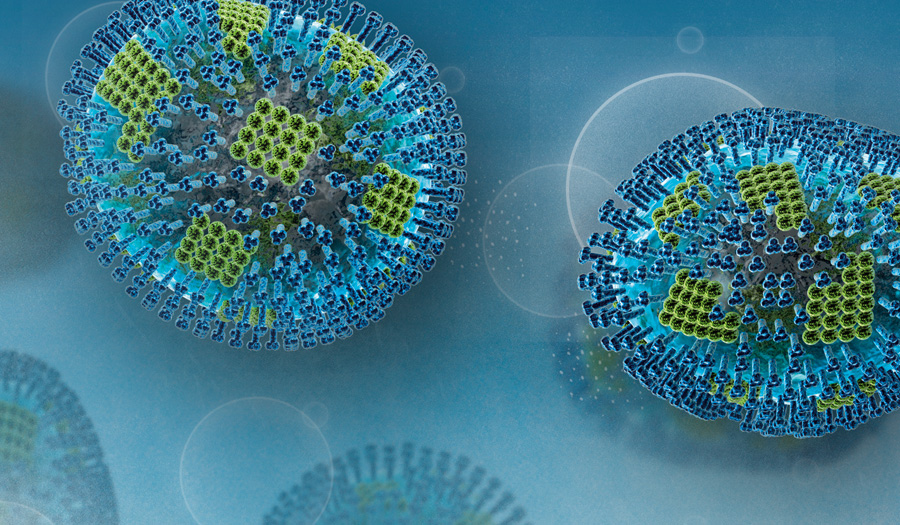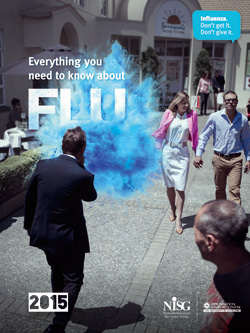 View / Download pdf version of this article
View / Download pdf version of this article

The Ministry of Health has announced that the first shipments of the two subsidised seasonal influenza vaccines for 2015,
Influvac and Fluarix, have been sent to providers who pre-ordered the vaccines.1 After an initial delay, a continuous supply
of the vaccines is expected to be available until the end of the influenza season.
 Further updates on the vaccine supply are available from:
www.influenza.org.nz
Further updates on the vaccine supply are available from:
www.influenza.org.nz
The later than normal arrival of the influenza vaccines will mean that the seasonal influenza programme will only just
have started when Immunisation Week began on April 20, 2015 (see: “Pertussis and influenza vaccination
are important themes of Immunisation Week”). The National Influenza
Specialist Group (NISG) “Flu Kit” for 2015 is available online and includes information about ordering the vaccine
and claiming funding.
 For further information, see: www.influenza.org.nz
For further information, see: www.influenza.org.nz
Pertussis and influenza vaccination were important themes of Immunisation Week
This year’s Immunisation Week aimed to raise awareness among parents about the importance of completing the scheduled
childhood immunisations, particularly parents of infants aged eight months or younger.2 Promoting pertussis
and influenza vaccination were key messages of Immunisation Week, with the slogans: “Flu can be anywhere”
and “Influenza don’t get it, don’t give it”.2
On-time administration of pertussis vaccines throughout life to prevent whooping cough was a major theme of Immunisation
Week. All infants should receive three doses of the subsidised pertussis vaccine by age six months (DTaP-IPV-HepB/HiB),
with booster doses at ages four (DTaP-IPV) and eleven years (Tdap).3 Pertussis vaccination is also subsidised
for women who are pregnant.3 The Tdap vaccine should be given to pregnant women between 28 to 38 weeks gestation.3 Immunising
adults and older children, that have regular contact with infants, e.g. fathers, siblings, grandparents and
other caregivers, can be used to provide a “cocoon of immunity” to help prevent infections until the infant
has received all their pertussis vaccinations. One dose of Tdap is sufficient for these people, however,
this is usually unsubsidised.3
 For further information see:
“Pertussis: halting the epidemic by protecting infants”, BPJ 51 (Mar, 2013) and
“Pertussis immunisation in pregnancy”, BPJ 60 (Apr, 2014)
For further information see:
“Pertussis: halting the epidemic by protecting infants”, BPJ 51 (Mar, 2013) and
“Pertussis immunisation in pregnancy”, BPJ 60 (Apr, 2014)
Two new strains have been included in the 2015 vaccines
The arrival of the 2015 seasonal influenza vaccines was delayed. This was due to a manufacturing reformulation with
the introduction of two new influenza strains in this year’s vaccines. The aim of reformulating the vaccine was to provide
better protection against the circulating influenza strains likely to predominate during the 2015 influenza season, based
on knowledge/experience from the 2014/15 Northern Hemisphere season. The components of the 2015 influenza vaccines are:4
- A/California/7/2009 (H1N1)-like virus
- A/Switzerland/9715293/2013 (H3N2)-like virus (new)
- B/Phuket/3073/2013-like virus (new)
The inclusion of the two new strains in the Southern Hemisphere vaccines is intended to avoid the vaccine mismatch problems
that were experienced in the 2014/15 Northern Hemisphere influenza season where the influenza A (H3N2) strain predominated.
The H3N2 and Phuket strains that have been included in the 2015 Southern Hemisphere influenza vaccines were not present
in the 2014/15 Northern Hemisphere’s influenza vaccines which resulted in low vaccine efficacy against the circulating
H3N2 strain.5 It is expected that the H3N2 strain will also predominate in New Zealand this winter.6 The
H3N2 strain tends to spread widely and has frequently been associated with severe disease and increased mortality in high-risk
groups, particularly in older people.7
Along with the two subsidised vaccines (Fluarix and Influvac), three other non-subsidised influenza vaccines will be
available in New Zealand in 2015.8 These are the trivalent vaccines Fluvax and Vaxigrip and the quadrivalent
vaccine FluQuadri.8 Fluvax and Vaxigrip both contain the California and Phuket strains along with a South
Australian strain which is expected to provide similar protection against H3N2 as the Switzerland strain in the subsidised
vaccines. The quadrivalent vaccine contains the same three strains as the subsidised trivalent vaccines along with one
additional B influenza virus strain.8 The availability of the unsubsidised influenza vaccines will vary between
locations depending on which vaccines individual providers decide to stock.
Pharmacies and occupational health providers that administer influenza vaccinations are expected to notify the patient’s
general practice so that their medical records can be updated.
 A list of pharmacies offering influenza vaccination is
available from:
www.influenza.org.nz/sites/default/files/Pharmacies%20Vaccinating%202015.pdf
A list of pharmacies offering influenza vaccination is
available from:
www.influenza.org.nz/sites/default/files/Pharmacies%20Vaccinating%202015.pdf
Who should receive the influenza vaccine?
All adults and children aged six months and older can be immunised against influenza, although the vaccines are only
subsidised for certain groups (see: “The subsidy groups have not changed from 2014”, It is recommended
that all people who meet the subsidy criteria are vaccinated. Vaccination should be encouraged in particular
for pregnant women, as this provides protection for the woman and her fetus during pregnancy, and then subsequently
the newborn child.
Influenza vaccination is also recommended (but not subsidised) for people in close contact with individuals at high
risk of complications. This includes healthcare workers and others with regular contact with immunocompromised people,
children and elderly people.
All healthcare providers and non-clinical practice staff should receive the annual influenza immunisation to
help reduce the spread of the virus and protect those people at greater risk of influenza complications. The proportion
of DHB employees who received the seasonal influenza vaccine has increased over the past few years, but remains suboptimal
(61% in 2014).9 All DHBs offer free influenza vaccination for their staff. There is no official influenza
vaccination rate published for primary care staff, however, it is thought that the rate is higher than the overall DHB
figure.
As well as getting vaccinated themselves, healthcare professionals have an important role in promoting the uptake of
influenza vaccination, as people may have become complacent about influenza after two relatively mild influenza seasons
in New Zealand in 2013 and 2014.10
Who should not receive the influenza vaccination?
Infants aged under six months should not be vaccinated.9 Significant protection
for young infants can be achieved by vaccinating the mother during pregnancy. Further protection may also be obtained
via “cocooning” i.e. immunising adults and older children who have frequent contact with the infant, e.g. parents, grandparents
and siblings.
People with an acute illness or fever (> 38°C) should not be vaccinated until they are well.9
People with a latex allergy should receive Influvac and not Fluarix, as the Fluarix needle shield contains
natural rubber latex.9
Influvac and Fluarix are both produced using hen’s eggs and therefore may contain residual amounts of egg proteins.
People who have had a confirmed anaphylactic reaction to egg protein may still be given the vaccine if the benefits
outweigh the risks, however, this should occur under specialist supervision, e.g. allergy specialist or paediatrician.11 The
Australian Society of Clinical Immunology and Allergy (ASCIA) guidelines for influenza vaccination in egg-allergic people
report that people who have had mild reactions or hypersensitivity to egg protein may receive influenza vaccination.11 However,
these individuals should undergo a 30-minute observation period after the vaccine has been given (the normal recommended
observation period is 20 minutes).11
By which route should the vaccines be administered?
Both Fluarix and Influvac can be administered as an intramuscular or subcutaneous injection.9 The intramuscular
route is generally preferred, although subcutaneous injection should be used for people with bleeding disorders, e.g.
thrombocytopenia, as bleeding can occur following intramuscular administration.9
How many doses should be administered?
Children aged six months to eight years who have not previously been vaccinated against influenza should receive two
doses of the influenza vaccine, administered four weeks apart, as they are more likely to be immunologically naive to
influenza.9 All other people, including children aged six months to eight years who have received an influenza
vaccine at any time in the past or anybody aged nine years or older receiving vaccination for the first time, only require
a single dose of the vaccine each year.9

Practice debate
There is growing consensus that the recommended 20 minute observation period may not be necessary for patients who have
received three or more previous influenza vaccinations, and have experienced no reaction. The argument for this is that
although the antigens may change in the vaccine each year, the other constituents of the vaccine remain the same, and
the overall risk of anaphylaxis from influenza vaccine is extremely low.
What is your personal/practice policy or opinion on this?
Comment online at the bottom of this article
The subsidy groups have not changed from 2014
The groups of people who are eligible to receive subsidised influenza vaccination are unchanged from 2014.12 The
eligible groups for 2015 are:12
- Women who are pregnant (influenza vaccination can be administered safely during any trimester and during breastfeeding)
- People aged 65 years or older
- People aged six months to 65 years with any medical conditions that place them at an increased risk of influenza complications
Medical conditions that place a person at a high risk, include:
- Coronary disease or chronic kidney disease
- Chronic respiratory conditions, e.g. asthma (if taking regular preventative medicines) or COPD
- Type 1 or 2 diabetes
- Immunosuppressed individuals, e.g. transplant recipients or those with HIV
- Autoimmune disorders, e.g. rheumatoid arthritis
- Cancer or epilepsy
Practices can provide subsidised doses of the influenza vaccine until July 31, 2015, after which time, people will have
to pay the full cost of the vaccine and administration.
 The full list of conditions that qualify a patient for subsidised vaccination is available from:
www.influenza.org.nz/eligibility-criteria
The full list of conditions that qualify a patient for subsidised vaccination is available from:
www.influenza.org.nz/eligibility-criteria
Acknowledgement
Thank you to Thank you to Associate Professor Nikki Turner, Department of General
Practice and Primary Health Care, Director CONECTUS and the Immunisation Advisory Centre, University of Auckland
for expert review of this article.
References
- National Influenza Specialist Group (NSIG). First shipment of funded influenza vaccine being sent to providers. NSIG,
2015. Available from:
www.influenza.org.nz/news/first-shipment-funded-influenza-vaccine-being-sent-proiveders-ministry-health (Accessed Apr, 2015).
- Health Protection Agency. Immunisation. Available from:
www.hpa.org.nz/what-we-do/immunisation (Accessed
Apr, 2015).
- Ministry of Health (MOH). Immunisation handbook. MOH, 2014. Available from:
www.health.govt.nz/publication/immunisation-handbook-2014
(Accessed Apr, 2015).
- World Health Organisation (WHO). Recommended composition of influenza virus vaccines for use in the 2015 southern
hemisphere influenza season. WHO, 2014. Available from:
www.who.int/influenza/vaccines/virus/recommendations/2015_south/en/ (Accessed Apr, 2015).
- World Health Organisation (WHO). Questions and answers: vaccine effectiveness and estimates for seasonal influenza
vaccines. WHO, 2015. Available from:
www.who.int/influenza/vaccines/virus/recommendations/201502_qanda_vaccineeffectiveness.pdf (Accessed Apr, 2015).
- Ministry of Health (MOH). 2015 seasonal influenza immunisation update. MOH, 2015. Available from:
www.influenza.org.nz/news/2015-influenza-immunisation-programme-update-ministry-health (Accessed
Apr, 2015).
- Huang QS, Lopez L, Wood T. Recommendation for seasonal influenza vaccine composition for New Zealand for 2015. ESR,
2014. Available from:
www.surv.esr.cri.nz/PDF_surveillance/Virology/FluVac/FluVac2015.pdf (Accessed
Apr, 2015).
- Immunisation Advisory Centre (IMAC). ImmNuZ - The official newsletter of the Immunisation Advisory Centre. IMAC,
2015. Available from:
www.immune.org.nz/sites/default/files/resources/newsletter/ImmNuZ%2081%20February%202015.pdf (Accessed Apr, 2015).
- Immunisation Advisory Centre (IMAC). Everything you need to know about flu. IMAC, 2015. Available from:
www.influenza.org.nz/sites/default/files/2015%20Flu%20Kit%20.pdf (Accessed Apr, 2015).
- National Influenza Specialist Group (NISG). New influenza vaccine for 2015 - media release for NZ Doctor. NSAIG,
2015. Available from:
www.influenza.org.nz/news/new-influenza-vaccine-2015-media-release-nz-doctor (Accessed Apr, 2015).
- Australian Society of Clinical Immunology and Allergy Inc. Guidelines for medical practitioners: Influenza vaccination
of the egg-allergic individual. 2010. Available from: www.allergy.org.au (Accessed Apr, 2015).
- National Influenza Specialist Group (NSIG). Eligibility criteria for free seasonal influenza vaccination for 2015.
NSIG, 2015. Available from: www.influenza.org.nz/eligibility-criteria
(Accessed Apr, 2015).